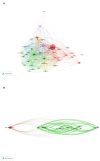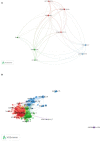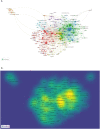Bibliometric Analysis and Visualization of Academic Procrastination
- PMID: 34733204
- PMCID: PMC8558228
- DOI: 10.3389/fpsyg.2021.722332
Bibliometric Analysis and Visualization of Academic Procrastination
Abstract
Numerous students suffer from academic procrastination; it is a common problem and phenomenon in academic settings. Many previous researchers have analyzed its relationships with other factors, such as self-regulation and academic success. This paper aims to provide a full outline of academic procrastination and explore the current hot spots and trends. Bibliometrix and VOSviewer were used to conduct quantitative analysis. The data was collected from the Web of Science core collection database, which contains 1,240 articles from the years 1938 to 2021. The analysis shows that the publication of articles on academic procrastination has been rapidly increasing since 1993. In terms of the most influential countries and institutions, the United states took a prominent lead among all countries, and the most productive institutions in this area were the University of Washington and University of California, Los Angeles. By analyzing the authors, we see that most authors like working with a few collaborators, leading to main groups of authors, such as Murat Balkis and June J. Pilcher. The most frequently cited author was Esther D. Rothblum. Based on the co-citation journals network, Personality and Individual Differences was the prolific and influential journal referring to the number of citations and articles it received. The VOSviewer tool identified the hot spots of academic procrastination, which were mainly distributed as follows: (a) procrastination, (b) academic procrastination, (c) self-regulation, (d) academic performance, and (e) motivation. Therefore, this paper is helpful for scholars and practitioners to know the trend of academic procrastination research comprehensively.
Keywords: VOSviewer; academic procrastination; bibliometric analysis; bibliometrix tool; the trend.
Copyright © 2021 Tao, Hanif, Ahmed and Ebrahim.
Conflict of interest statement
The authors declare that the research was conducted in the absence of any commercial or financial relationships that could be construed as a potential conflict of interest.
Figures











References
-
- Aghaei Chadegani A., Salehi H., Yunus M. M., Farhadi H., Fooladi M., Farhadi M., et al. . (2013). A comparison between two main academic literature collections: web of science and scopus databases. Asian Soc. Sci. 9, 18–26. 10.5539/ass.v9n5p18 - DOI
-
- Akpur U. (2017). Predictive and explanatory relationship model between procrastination, motivation, anxiety and academic achievement. Eur. J. Educ. Res. 69, 221–240. 10.14689/ejer.2017.69.12 - DOI
-
- Balkis M., Duru E. (2016). Procrastination, self-regulation failure, academic life satisfaction, and affective well-being: underregulation or misregulation form. Euro. J. Psychol. Educ. 31, 439–459. 10.1007/s10212-015-0266-5 - DOI
-
- Batool S. S. (2020). Academic achievement: interplay of positive parenting, self-esteem, and academic procrastination. Aust. J. Psychol. 72, 174–187. 10.1111/ajpy.12280 - DOI
Publication types
LinkOut - more resources
Full Text Sources

